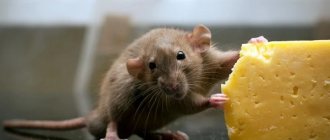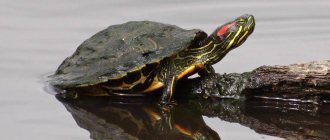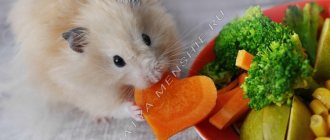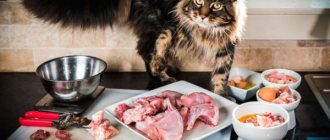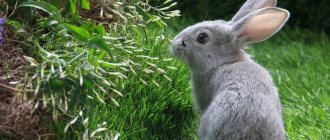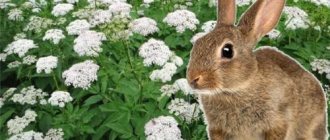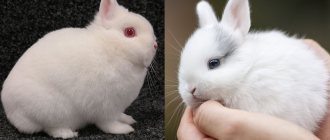Grass must be present in the diet of rabbits; it is a source of vitamins and is very popular with the ears. However, these animals have an overly sensitive digestive system. Violating the rules of feeding rabbits sometimes leads to dire consequences. Experienced farmers know that they should not give grass to their pets after rain, as well as freshly cut grass. It turns out that such food is harmful to animals. What danger it poses, readers will learn from this article.
Rabbit on a walk
Grass feeding rules
If you do not follow the rules, even beneficial grass for rabbits can be harmful:
- Young grass should be added to food, as it contains a lot of protein. Later grass may cause digestive problems.
- You should include different types of herbs in your diet as each has its own benefits.
- It is forbidden to give grass with dew. This causes severe digestive upset, which can be fatal.
- Before feeding, the grass must be dried and withered.
- After a long break, the herb should be reintroduced gradually. It should be given after the concentrated product.
- After the introduction of a new product, it is necessary to monitor the condition of the animals.
- The grass should be mowed on a sunny day. This should not be done during or immediately after rain. Excess moisture is harmful to rabbits' stomachs.
- Do not collect grass growing near roads, transport routes, houses or businesses. It accumulates harmful substances.
- Winter preparations should begin as soon as the plants bloom.
- You should check that the hay stored for the winter does not contain mold or rot.
- The grass should be dried for a short time. It is desirable that it retains its color and smell.
- When feeding legumes, cereals must be added to them.
How to properly introduce greens into your diet?
To begin, start with dried herbs. We mow it down and let it lie in the sun for 2-3 days, to speed up the process you can dry it in the oven or electric dryer. We give this grass for about a week, then we start mixing some fresh herbs into it and feed it again for 5-7 days.
All this time we monitor the condition of the animal, if no problems are observed, then after about 2 weeks, you can safely start giving fresh herbs to your rabbit. nibbles grass One rabbit can eat no more than 50 g of grass per day. Over the next 15 days, very gradually increase the amount of greens to 1 - 1.5 kg.
Note! The grass must be dry. Do not give it to your animal early in the morning when there is still dew outside or after rain.
Yarrow, dandelion, and plantain are useful for rabbits.
Green food should be varied, as the same grass every day will lead to decreased appetite in rabbits, as well as poor digestibility. Make sure the grass is clean and free of chemicals and herbicides.
Don't forget that a rabbit's main diet is hay. You can provide grass in the summer and spring as a supplement to the diet, but do not completely replace hay with it.
Meadow and forest herbs
It is advisable not to collect plants that grow in forests, meadows and fields near roads and hazardous plants. Young herbs will bring more benefit to rabbits, so it is recommended to collect and prepare raw materials while the stems are soft and buds have not appeared. Hay from a later cut is high in fiber and has a low nutrient content. This type of food will negatively affect the animals’ digestion and will not bring any beneficial effect to the body.
Is it possible to give rabbits fresh green grass? Rodents are naturally endowed with a weak stomach. If animals are fed freshly cut grass, their stomach may become swollen or diarrhea may occur, so it is not recommended to use fresh plants in the diet ; first they need to be dried a little. Rabbits should be fed by combining forbs with roughage, this way they can avoid digestive disorders.
The most nutritious and beneficial plants for rabbits among meadow grasses:
- Clover. This perennial plant can be found near rivers and ponds. It is allowed to feed small portions of clover to rabbits; it has a high protein content.
- Lupine fodder. It is recommended to give the legume plant to animals in combination with other foods, otherwise it can cause digestive system upset.
- Alfalfa. It is the most useful supplement for nursing rabbits and young animals. Contains a large amount of amino acids and protein.
- Plantain. The leaves of the meadow plant are rich in protein. Dried plantain can be stored for 3 years. Regular consumption of plantain leaves will help rodents improve digestion.
Meadows and fields are very rich in herbs. Many of the varieties are endowed with medicinal properties. Eating forest and meadow plants by rabbits will have a beneficial effect on their development and health. Heather, hogweed, tansy, comfrey and bluegrass, burdock and horse sorrel are perfect for feeding rodents.
Nettle as food for rabbits
Leaves and stems of this plant are often added to animal feed. Nettle is useful for both young animals and adults. The greatest amount of useful and valuable substances is found in plants during flowering.
In order not to harm animals, you should know how to properly feed them with nettles:
- The collected herbs should be rinsed well with running water, then doused with boiling water. This will help get rid of the burning sensation.
- Cut it and give it to rabbits in this form. Can be mixed with other types of herbs or used as a meal on its own.
Tops of garden crops
In addition to forest, steppe and field grasses, tops of garden crops are suitable:
- carrots;
- turnips;
- beets;
- radish;
- leaves of strawberry, Jerusalem artichoke, celery, basil;
- aerial parts of Savoy and Brussels sprouts;
- spinach and parsley.
Domestic and decorative rabbits are given different types of salads, with the exception of lettuce, which they do not like.
Fresh carrots are the preferred food ingredient for all rabbits.
To prepare plants for the winter, young grass is used, which has not yet had time to release its flowers. Wheatgrass, meadow and steppe grasses, and clover are used for drying.
Freshly cut grass does not dry for long. High-quality hay should be green in color and have a pleasant aroma. Hay that smells musty and contains damp grass is not suitable for feeding pets.
Hay is dried in a well-ventilated area. For ornamental animals, pet stores sell ready-made hay of various compositions.
Hay is a winter alternative to fresh greens.
If the grass is dried in the open air (in the summer), ultraviolet light provides additional disinfection of the feed, because Most bacteria are afraid of direct sunlight.
Medicinal herbs for rabbits
Carrot, beet tops and black radish greens are the animals' favorite food. In nature, there is a wide variety of medicinal plants. Clover, plantain, alfalfa, chamomile and many other species provide great benefits to rabbits. Some species can cure diseases.
The most popular medicinal herbs:
- Chamomile. Has bactericidal and anti-inflammatory properties. The stems and leaves of the herb help normalize the digestion process, suppress the effects of toxins, and cleanse the body.
- Plantain. Fresh leaves have antimicrobial properties. When consuming this useful herb, wounds and ulcers heal quickly.
- Sagebrush. It is not recommended to feed rabbits uncontrolled wormwood. With the correct dosage of the herb, you can normalize the process of gas formation, increase your pets’ appetite and rid them of parasites.
- Nettle. Hemostatic agent. Proper feeding of this grass will help rabbits quickly build muscle mass and strengthen the immune system. The plant is recommended to be given to pets as a laxative.
Other herbs in the animal diet
Medicinal green grass is suitable for rare feeding in small portions. Animals should be fed only with young shoots. In order for animals to grow and gain weight, the amount of feed must gradually increase.
The following garden plants are suitable for the menu of long-eared pets: celery, parsley shoots and leaves, basil leaves, spinach, and the above-ground part of strawberries. Lettuce leaves are preferred by ornamental species. Suitable for herbs growing in local forest plantations and steppes: coltsfoot, wheatgrass, fireweed, hemp, sweet clover, sorrel, sow thistle.
What branches can rabbits eat?
Medicinal green grass is suitable for rare feeding in small portions. Trees and shrubs are a source of roughage. Garden trees (apple trees, acacias, pears) are suitable for this; maple or linden branches will also be excellent food.
From bushes you can give branches of raspberries and currants. Sometimes ornamental species can be fed with branches of birch, oak, rowan, pear, and juniper. Birch branches have medicinal properties. This is an excellent diuretic. Willow and linden have analgesic properties. When diarrhea appears, oak and alder branches are given.
Is it possible to give rabbits wormwood, tansy, clover, quinoa, dandelion, burdock?
In addition to green mass, rabbits must consume rough and succulent feed. Green mass for animal nutrition consists of young shoots of wild herbs and tops of garden plants.
It is recommended to pay attention to the following types of herbs:
- Quinoa. The common weed is excellent for feeding rabbits. Rabbit breeders solve two important problems at once: they free the garden from weeds and feed their pets healthy greens.
- Sagebrush. Eared pets like grass with a specific smell. The composition of wormwood is rich in vitamins. Flavonoids, tannins and organic acids help strengthen the immune system of rabbits.
- Clover. The wild plant belongs to the legume family. This is one of the most beneficial types of green food for rabbits. Animals should be fed clover in small portions. If you feed too much food, digestive problems may occur.
- Burdock. The plant contains vitamins and microelements: insulin, resins, essential oils. Feeding should be given 2 times a week; more frequent feeding will cause a deterioration in the pet’s well-being.
- Tansy. Contains retinol, ascorbic acid and B vitamins. The plant attracts animals with its aromatic smell. However, excessive consumption of tansy can cause disruption of the normal functioning of digestion and intoxication.
- Dandelion. This plant should make up no more than a third of the volume of green food. Dandelions have a beneficial effect on animal digestion and increase appetite. Dandelion stems and foliage are especially useful for young offspring and females during lactation.
Herbs need to be alternated and the dosage observed. Rabbits have a very delicate digestive system, so feeding must be done in accordance with the rules.
Useful for metabolic processes
Table salt (NaCl) is made up of two minerals - chlorine and sodium. With their participation, metabolic processes occur in any living organism. These substances are necessary for the production of gastric juice and for healthy heart function.
When consuming this product, it is important not to overdo it. If salt easily enters the body (with food), it takes a lot of time to get out
It stays in tissues for up to five days.
Read also: Skin diseases of rabbits: photos and descriptions, symptoms and treatment
When keeping rabbits, the first thing you need to do is ensure their rapid and healthy growth. According to the norm, food should contain proteins, fats and minerals. This is difficult to achieve with simple green food. In other words, there must be nutritional value and quality. We will tell you exactly what products are needed below, but giving salt to rabbits is a must. This type of feeding is called a solid food base.
Table salt is also one of the most accessible minerals.
In order for the rabbit’s body to work and function normally, salt can be given and is even necessary.
What herbs should not be given to rabbits?
Despite the abundance and variety of herbs suitable for feeding rodents, there is an impressive number of plants that can not only cause harm, but also kill animals. A significant part of dangerous herbs lose their properties after drying, which is why it is so important to feed rabbits with dry grass.
When preparing forbs, it is recommended to ensure that the following poisonous plants do not get into the mixture:
- Hellebore. When animals are poisoned with this herb, they experience vomiting, diarrhea, and excessive salivation.
- Cornflower. Despite its external beauty, the plant causes paralysis and convulsions.
- Hemlock. After a poisonous plant enters the rodent's body, a loss of strength occurs, the hind legs are paralyzed and convulsions appear.
- Datura common. Disturbs the functioning of the cardiovascular system of animals.
- Marsh marigold. Causes bloating, diarrhea and frequent urination.
- Celandine. Poisoning leads to weakness and indigestion.
- Buttercup. The plant can cause acute abdominal pain. In case of poisoning, vomiting and diarrhea occur.
The list of poisonous plants is quite wide, but not all of them retain dangerous properties after drying. When preparing green food, it is important to know which grass should not be given to rabbits in large quantities. Some plants can provoke various types of disorders, but in small quantities they can be beneficial. For example, rabbits love corn very much, but its high carbohydrate content can cause excess gas. Therefore, when including a new plant in your pets’ diet, it is better to study its beneficial properties and side effects in advance.
Other wild crops
In addition to the plants described above, rabbits love the following grass fresh in summer and dried in winter:
- clover (wild clover);
- shiritsa;
- veres;
- carrot;
- sweet clover;
- sorrel (horse sorrel);
- yarrow;
- mouse peas;
- quinoa;
- American;
- whine;
- common thyme (thymus vulgaris);
- sow thistle;
- shepherd's purse;
- burdock.
Almost all of them have healing properties and have a beneficial effect on the functioning of the digestive system, promoting the full growth and development of both young animals and adults.
It should be remembered that grasses are, first of all, food for rabbits. If there is any pathology, plants cannot cure the problem. The healing properties of various crops will promote recovery, but will not replace full treatment.
Poisonous plants
Not all grass can be beneficial for rabbits. Some representatives of the flora cause quite severe poisoning in eared pets, which can even lead to death. For rabbit breeders, the ability to identify plants so as not to harm their pets is very important.
It is known that such a simple procedure as drying can reduce the toxicity of some herbs or completely neutralize them. But at the same time, there are greens that, when dried, on the contrary, accumulate dangerous toxins. But some green seedlings, when ensiled, become deadly poisons for fluffies.
| The most poisonous plants | |
| Buttercup | It is especially dangerous when fresh. Causes severe diarrhea, bloating, food poisoning. When dried it becomes less dangerous. |
| Lumbago (Sleep-grass) | Poisoning accompanied by convulsions or paralysis. When dried, it almost completely loses its toxic properties. |
| Wolfsbane(Wrestler) | A particularly poisonous species of buttercup. Causes poisoning, which ends in death. Equally dangerous in fresh and dried form. |
| White hellebore | Diarrhea, bloating, difficulty breathing, even death of the animal |
| Colchicum (Colchicum) | Fatal poisoning |
| Great celandine | Diarrhea, bloating, cramps, possible death of the animal |
| Less poisonous herbs may cause symptoms of poisoning; eared animals should not be allowed to eat them. | |
| Datura common or stinking | |
| Wild mustard | |
| wild radish | |
| Avran officinalis | |
| Calla lily (Calla) | |
| Common cockle (Agrostemma) | |
| Juniper | |
| Astragalus | |
| Tobacco | |
| Nightshade | |
| Black Sea rhubarb | |
| Eggplant | |
Before mowing the grass, make sure that there are no plants in the area that are poisonous to rabbits.
| Plants that are less often fed to rabbits, but are also worth remembering about their toxicity: | foxglove castor bean horsetail hemlock henbane aloe vera apple and pear seeds almond macadamia nut all parts of apricot (except fruit) avocado begonia lupine bracken | ivy carnation coneflower dracaena delphinium ficus yucca Kalanchoe sweet potato snowdrop poppy peony oak leaves valerian cornflower horned |
Dangerous buttercups
First of all, avoid collecting these particular poisonous herbs for rabbits. Buttercups are easy to recognize; they are found almost everywhere. You definitely need to know this plant, be able to distinguish it from dozens of others. Its yellow flower has a five-leaf calyx and a five-petal corolla. They usually grow in low-lying and damp places and bloom from spring to autumn. They contain a strong poison, protoanemonin, which is dangerous for all types of animals. Moreover, when dried, the plant becomes absolutely safe, the poison disappears.
Be very responsible about what grass you feed your rabbits. When eating large quantities of buttercups, acute poisoning occurs. The animal stops eating, suffers from attacks of pain, and the gastrointestinal tract is most affected. However, death is not always the case, unless, of course, you feed the animal exclusively buttercups. But there are also enough consequences such as decreased immunity and slowed growth. It will take a lot of effort to return the animal to a full life. However, remember that plants growing in partial shade are usually more poisonous than those that are exposed to the bright sun.
Is it possible to give rabbits grass after it rains?
Giving wet grass to animals is strictly prohibited. There are important reasons for the ban:
- Wet grass speeds up the fermentation process in the body, which increases the likelihood of bloating.
- This food is poorly digested and absorbed by rabbits. It won't do any good.
- Wet greens contain many bacteria, including those that are harmful to rabbits. This may cause the development of certain diseases.
Before giving green food, it must be thoroughly dried. Then the animals will receive the necessary nutrients in full without harm to the body.
Important information
You can feed rabbits only young grasses that contain the greatest amount of useful and nutritious substances. They are easily absorbed by the gastrointestinal tract.
Plants that are harvested late for feeding have a high fiber content and take a long time to digest in the stomach.
It is not advisable to feed rabbits the same grass - a variety of greens will be many times more useful.
It is not recommended to feed domestic rodents with fresh, just mown grass or wet, after rain, washed with dew. This can lead to serious problems in the digestive system.
The cut green fodder is dried and only then given to the animals - this way it is better absorbed by the stomach.
Wet grass causes fermentation in the stomach. As a result, the rabbit experiences discomfort, bloating and general malaise. In addition, a humid environment is an excellent place for the development of pathogenic microorganisms. Eating such grass can cause severe poisoning.
It is forbidden to give yellow grass, which contains many carcinogenic substances.
What to do if your rabbit is poisoned
Poisoning of animals with poisonous harmful herbs can be determined by the behavior and appearance of the rabbit: it refuses to eat, loose stools and vomiting appear, and its gait becomes unsteady and slow.
What should you do if symptoms indicate poisoning? The first step is to remove any remaining food from the feeder in order to protect the animal from new poison entering the body. Then you can try to cleanse the stomach and induce vomiting using fresh milk (2 tablespoons 3 times a day). Egg yolk or a decoction of flax seeds will help you recover from poisoning. If a rabbit has convulsions, a decoction of oak or willow bark will be an effective medicine.
At the first signs of poisoning, contact a specialist!
In order for rabbits to always enjoy excellent health and strong offspring, it is necessary to carefully monitor their nutrition. Food should be varied and contain useful substances and microelements. Green herbs, fresh and dry, are an integral part of a complete rabbit diet. The main thing is to know which grass is safe for the animal and which is not.
How to grow green food on your own plot
You can grow salads and grains on the windowsill for rabbits - barley, wheat, oats, buckwheat. They are rich in vitamins B-complex, E and K, phosphorus, magnesium, potassium, protein. They contain a lot of fiber, which is beneficial for the animal. Such food is not only environmentally friendly, but also healthy.
Any container is suitable for growing grass. It could even be an empty tin can or flower pot. Greens do not need a deep layer of soil, so it is better to use plastic boxes. Plants are sometimes grown in sawdust or cat litter.
The seeds are sown scattered and the substrate is sprayed with a spray bottle. After the seeds are placed in the “soil” and watered, cover the container with film to create a greenhouse effect. Everything will germinate in 5 days.
Rabbit breeders recommend using grain seeds for planting, which are purchased to feed the pet. They germinate better and do not contain herbicides that are used to treat grains in the agricultural sector.
For planting in the ground on personal plots, both grains and herbs of agricultural importance are used - mustard, clover, alfalfa. You need to sow shallowly in moist soil. After sowing, monitor the condition of the soil and water when dry.
To organize crop rotation, you can plant greens in batches every few days.
Symptoms of infectious stomatitis
Viral stomatitis in rabbits occurs in mild and severe forms. The manifestation of symptoms depends on age, physiological and individual characteristics of the body, and immune potential.
In mild forms, biting midge is practically asymptomatic. The disease often goes away on its own without any treatment after 2–4 days. Small ulcers are visible on the muzzle, lips, and hairless areas of the body. The fur becomes wet on the face. Saliva is released only from the corners of the mouth. A white coating appears on both sides of the muzzle. The tongue turns white, the nose becomes warm and soft. At the same time, unlike a severe form of infection, the ulcers are not so deep and do not itch much. Appetite is normal or slightly reduced. In general, the rabbits remain active and mobile.
In mild cases, a white coating appears on the tongue
If the infection is severe, if treatment is not started, the biting midge will die within two weeks.
Symptom of infectious stomatitis:
- constantly wet face, chest;
- profuse salivation (secretion of foamy saliva);
- loss of appetite, refusal to feed;
- the presence of ulcers in the oral cavity;
- weight loss;
- inflammation of the oral mucosa;
- severe exhaustion;
- glued wet fur on the neck, muzzle, sternum;
- uncontrolled diarrhea.
Sick rabbits have swollen tongues. There are noticeable ulcers and multiple ulcerations on it. The rabbit constantly rubs its face with its paws and experiences severe pain and discomfort. The condition of the coat deteriorates. Animals with wet faces look emaciated and take on an unkempt appearance. The wool falls out and sticks together. Wounds and scratch marks appear on the body. As the disease progresses, the inflammatory process covers the gastrointestinal tract of animals.
Severe form of stomatitis
Midge can occur in rabbits in an atypical form, which is characterized by slight inflammation. The rabbit's muzzle and chin do not get very wet. The appetite is preserved, the condition of the animals is stable. The infection clears up in 2–3 days.

